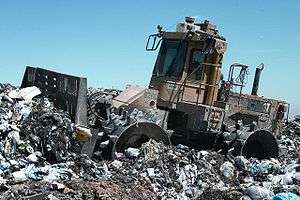Locally unwanted land use

In land-use planning, a locally unwanted land use (LULU) is a land use that creates externality costs on those living within close proximity. These costs include potential health hazards, poor aesthetics, or reduction in home values. Such facilities with such hazards need to be created for the greater benefits that they offer society.[1] "Neighbor is crying 'NIMBY!' because the LULU threatens the considerable value that her property represents to her."[2]
LULUs can include power plants, dumps (landfills), prisons, roads, factories, hospitals and many other developments. Planning seeks to distribute and reduce the harm of LULUs by zoning, environmental laws, community participation, buffer areas, clustering, dispersing and other such devices. Thus planning tries to protect property and environmental values by finding sites and operating procedures that minimize the LULU's effects.
Types
- Landfill
- Road/Highway
- Power station
- Prison
- Hospital
- Health food store
- Luxury real estate
- Halfway house
- Nuclear power
- Sewage treatment
- Superfund
Inequality
It has been suggested that a correlation exists between location of sites considered as locally unwanted land uses and proximity to minority populations as a result of market dynamics. That is, externalities associated with LULUs (such as poor aesthetics, lack of desirable amenities, etc.) tend to discourage high-earning buyers from moving to the area, and thus perpetuate the cycle in which low income individuals have few choices except those in areas with LULUs. This effectively lowers home values. Further, the same market forces, especially those that may discriminate against individuals of color, could make it so that these areas happen to be populated predominantly by minorities.[3]

"Recent studies have unveiled correlations between urban land clean-up; investment in green or open space creation or rehabilitation, waterfront redevelopment, ecological/green design or ecological restoration; and changes in demographic patterns and property values. For instance, as contaminated Superfund sites are cleaned up, housing values appreciate by up to 18% within a 1 km radius. When sites are removed from the Superfund list, mean household income tends to increase by 26% and the share of college graduates by 31%."[4]
Though they are seen as positive, amenities such as high-end grocery stores like Whole Foods can also act as an unwanted use of land. LULUs are typically thought of as dumps, landfills, etc., with the increasing interest in "green" amenities like that of high-end health food stores, a new kind of "environmental gentrification"[5] is becoming more and more common. What makes a LULU such as this unique is that they cause displacement, whereas a landfill, dump, roads, or prisons simply discourage home-buyers from entering the area and keep home prices low. High-end health food stores such as Whole Foods causes displacement by attracting high-earning home buyers into the area, causing rents and home prices to rise.[6] This has been dubbed the "Whole Foods effect".[5]
Gentrification
The "Whole Foods Effect", among other amenities being added to neighborhoods in growing communities across the U.S., is one sign pointing toward the larger problem of gentrification. Gentrification is a process of renovation and revival of deteriorated urban neighborhoods "thus improving property values but often displacing low-income families and small businesses." [7] With this process often comes LULU's such as Whole Foods, luxury housing, etc.
Superfund
.jpg)
Superfund, or the Comprehensive Environmental Response, Compensation, and Liability Act of 1980, was created to mitigate the cleanup and costs thereafter of hazardous waste sites. Superfund sites are often thought of when discussing LULU's. Love Canal was the first superfund site, established because of chemical waste that was being dumped into the canal by Hooker Electrical Company, later known as Hooker Chemical Company. The incident attracted widespread media attention and the neighborhoods surrounding Love Canal have since been destroyed.[8]
Notable cases
- San Francisco
- "Luxury condominiums, organic ice cream stores, cafes that serve soy lattes and chocolate shops" are quickly replacing amenities that are widely used by the Latinx communities surrounding the Mission District, such as .99 cent stores, bodegas, and rent controlled apartments."[9]
- Boston
- "More than a fifth of Boston neighborhoods – 21 percent of the 57 city [census] tracts described as eligible to gentrify – have become gentrified since 2000, as top incomes of residents and home values rose, according to Governing magazine. In the previous decade (1990 to 2000) only 6.7 percent became gentrified out of the 75 eligible tracts." [10]
- Brooklyn
- "Like longtime tenants from San Francisco to Harlem, the African-Americans and West Indians who have made their homes for generations in this Brooklyn neighborhood are scattering, muscled out by surging rents and, tenant advocates say, landlords who harass tenants, withhold repairs or use evictions to make room for higher-income renters. Some move in with relatives. Some scrabble for a foothold in one of the city’s remaining cheap areas. And some give up on New York altogether." [11]



See also
| Look up LULU in Wiktionary, the free dictionary. |
References
- ↑ Goodstein, Eban S.; Polasky, Stephen. Economics and the Environment (7th ed.). Wiley. pp. 133–136.
- ↑ Brion, Denis J. "An Essay on LULU, NIMBY, and the Problem of Distributive Justice". Boston College Environmental Affairs Law Review. 15 (3).
- ↑ Liu, Feng. "Dynamics and Causation of Environmental Equity, Locally Unwanted Land Uses, and Neighborhood Changes". Environmental Management. 21 (5): 643–656. doi:10.1007/s002679900057. ISSN 0364-152X.
- ↑ "Hazardous Waste Cleanup, Neighborhood Gentrification, and Environmental Justice: Evidence from Restricted Access Census Block Data". American Economic Review. 101 (3): 620–624.
- 1 2 Goss, Adeline. "Transcript: The "Whole Foods Effect": A grocery's role in transforming cities" (PDF).
- ↑
- ↑ "Gentrification".
- ↑ "After 10 Years, the Trauma of Love Canal Continues".
- ↑ "Gentrification Spreads an Upheaval in San Francisco's Mission District".
- ↑ "Boston neighborhoods reshaped by gentrification".
- ↑ "Gentrification in a Brooklyn Neighborhood Forces Residents to Move On".
- ↑ "San Francisco Gentrification Maps and Data".
- ↑ "Boston Gentrification Maps and Data".
- ↑ "New York City Gentrification Maps and Data".